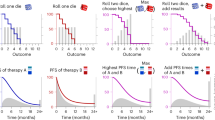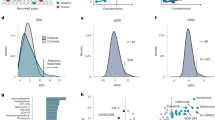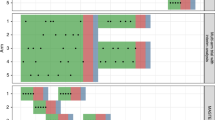Abstract
Anticancer agents used in combination are fundamental to successful cancer treatment, particularly in a curative setting. For dual-agent phase I trials, the goal is to identify drug doses and schedules for further clinical testing. However, current methods for establishing the recommended phase II dose for agents in combination can fail to fully explore drug interactions. With increasing numbers of anticancer drugs requiring testing, new adaptive model-based trial designs that improve on current practice have been proposed, although uptake has been minimal. We describe the methods available and discuss some of the opportunities and challenges faced in dual-agent phase I trials, as well as giving examples of trials in which adaptive designs have been implemented successfully. Improving the design and execution of phase I trials of drug combinations critically relies on collaboration between the statistical and clinical communities to facilitate the implementation of adaptive, model-based designs.
Key Points
-
Combination therapy is the mainstay of life-prolonging cancer treatments and increasingly uses both traditional cytotoxic and targeted agents
-
Standard rule-based methods for dual-agent clinical trial design have considerable limitations, including slow dose-escalation and that they only consider the outcome of the last cohort to guide escalation
-
Adaptive model-based clinical trial designs can be more accurate in recommending combinations to take forward into phase II trials and provide greater flexibility for investigators
-
Additional features of model-based designs can be extended to include measurements of chronic toxicity, efficacy, pharmacokinetics and pharmacodynamics, which can be particularly attractive in trials of targeted agents
-
Successful examples of model-based designs in practice exist and their further use is strongly encouraged
This is a preview of subscription content, access via your institution
Access options
Subscribe to this journal
Receive 12 print issues and online access
$209.00 per year
only $17.42 per issue
Buy this article
- Purchase on Springer Link
- Instant access to full article PDF
Prices may be subject to local taxes which are calculated during checkout







Similar content being viewed by others
References
Marusyk, A., Almendro, V. & Polyak, K. Intra-tumour heterogeneity: a looking glass for cancer? Nat. Rev. Cancer 12, 323–334 (2012).
Dancey, J. E. & Chen, H. X. Strategies for optimizing combinations of molecularly targeted anticancer agents. Nat. Rev. Drug Discov. 5, 649–659 (2006).
Masters, J. R. & Köberle, B. Curing metastatic cancer: lessons from testicular germ-cell tumours. Nat. Rev. Cancer 3, 517–525 (2003).
Meropol, N. J., Kris, M. G. & Winer, E. P. The American Society of Clinical Oncology's blueprint for transforming clinical and translational cancer research. J. Clin. Oncol. 30, 690–691 (2011).
Park, S. R., Davis, M., Doroshow, J. H. & Kummar, S. Safety and feasibility of targeted agent combinations in solid tumours. Nat. Rev. Clin. Oncol. 10, 154–168 (2013).
Al-Lazikani, B., Banerji, U. & Workman, P. Combinatorial drug therapy for cancer in the post-genomic era. Nat. Biotechnol. 30, 679–692 (2012).
Dragalin, V. Adaptive designs: terminology and classification. Drug Inf. J. 40, 425–435 (2006).
Sweeting, M. J. & Mander, A. P. Escalation strategies for combination therapy phase I trials. Pharm. Stat. 11, 258–266 (2012).
Berry, D. A. Adaptive clinical trials in oncology. Nat. Rev. Clin. Oncol. 9, 199–207 (2011).
Ivy, S. P., Siu, L. L., Garrett-Mayer, E. & Rubinstein, L. Approaches to phase 1 clinical trial design focused on safety, efficiency, and selected patient populations: a report from the clinical trial design task force of the national cancer institute investigational drug steering committee. Clin. Cancer Res. 16, 1726–1736 (2010).
LoRusso, P. M., Boerner, S. A. & Seymour, L. An overview of the optimal planning, design, and conduct of phase I studies of new therapeutics. Clin. Cancer Res. 16, 1710–1718 (2010).
Le Tourneau, C., Lee, J. J. & Siu, L. L. Dose escalation methods in phase I cancer clinical trials. J. Natl Cancer Inst. 101, 708–720 (2009).
Babb, J. S. & Rogatko, A. In Advances in Clinical Trial Biostatistics (ed. Gellar, N. L.) 1–40 (CRC Press, 2003).
Storer, B. E. Design and analysis of phase I clinical trials. Biometrics 45, 925–937 (1989).
Faries, D. Practical modifications of the continual reassessment method for phase I cancer clinical trials. J. Biopharm. Stat. 4, 147–164 (1994).
O'Quigley, J. & Reiner, E. A stopping rule for the continuous reassessment method. Biometrika 85, 741–748 (1998).
Zohar, S. & Chevret, S. The continual reassessment method: comparison of Bayesian stopping rules for dose-ranging studies. Stat. Med. 20, 2827–2843 (2001).
Cheung, Y. K. & Chappell, R. Sequential designs for phase I clinical trials with late-onset toxicities. Biometrics 56, 1177–1182 (2000).
Thall, P. F. & Lee, S. J. Practical model-based dose-finding in phase I clinical trials: methods based on toxicity. Int. J. Gynecol. Cancer 13, 251–261 (2003).
O'Quigley, J., Pepe, M. & Fisher, L. Continual reassessment method: a practical design for phase 1 clinical trials in cancer. Biometrics 46, 33–48 (1990).
Carter, S. in The Design of Clinical Trials in Cancer Therapy (ed. Staquet, M.) 242–289 (Futura Publishing Co., 1972).
Babb, J., Rogatko, A. & Zacks, S. Cancer phase I clinical trials: efficient dose escalation with overdose control. Stat. Med. 17, 1103–1120 (1998).
O'Quigley, J. & Zohar, S. Experimental designs for phase I and phase I/II dose-finding studies. Br. J. Cancer 94, 609–613 (2006).
Kang, S.-H. & Ahn, C. W. An investigation of the traditional algorithm-based designs for phase 1 cancer clinical trials. Drug Inf. J. 36, 865–873 (2002).
Iasonos, A. et al. The impact of non-drug-related toxicities on the estimation of the maximum tolerated dose in phase I trials. Clin. Cancer Res. 18, 5179–5187 (2012).
Braun, T. M. & Alonzo, T. A. Beyond the 3+3 method: expanded algorithms for dose- escalation in phase I oncology trials of two agents. Clin. Trials 8, 247–259 (2011).
Flournoy, N. in Case Studies in Bayesian Statistics (eds Gatsonis, C., Hodges, J. S., Kass, R. E. & Singpurwalla, N. D.) 324–336 (Springer-Verlag, 1993).
Legedza, A. T. & Ibrahim, J. G. Heterogeneity in phase I clinical trials: prior elicitation and computation using the continual reassessment method. Stat. Med. 20, 867–882 (2001).
Speigelhalter, D. J., Abrams, K. R. & Myles, J. P. Bayesian Approaches to Clinical Trials and Health-Care Evaluation (John Wiley & Sons, 2004).
Rosenberger, W. F., Canfield, G. C., Perevozskaya, I., Haines, L. M. & Hausner, P. Development of interactive software for Bayesian optimal phase 1 clinical trial design. Drug Inf. J. 39, 89–98 (2005).
Thall, P. F., Millikan, R. E., Mueller, P. & Lee, S. J. Dose-finding with two agents in phase I oncology trials. Biometrics 59, 487–496 (2003).
Thall, P. F. Bayesian models and decision algorithms for complex early phase clinical trials. Stat. Sci. 25, 227–244 (2010).
Iasonos, A. & O'Quigley, J. Interplay of priors and skeletons in two-stage continual reassessment method. Stat. Med. 31, 4321–4336 (2012).
Goodman, S. N., Zahurak, M. L. & Piantadosi, S. Some practical improvements in the continual reassessment method for phase I studies. Stat. Med. 14, 1149–1161 (1995).
Paoletti, X. et al. Using the continual reassessment method: lessons learned from an EORTC phase I dose finding study. Eur. J. Cancer 42, 1362–1368 (2006).
Mick, R. & Ratain, M. J. Model-guided determination of maximum tolerated dose in phase I clinical trials: evidence for increased precision. J. Natl Cancer Inst. 85, 217–223 (1993).
Piantadosi, S. & Liu, G. Improved designs for dose escalation studies using pharmacokinetic measurements. Stat. Med. 15, 1605–1618 (1996).
Neuenschwander, B., Branson, M. & Gsponer, T. Critical aspects of the Bayesian approach to phase I cancer trials. Stat. Med. 27, 2420–2439 (2008).
Braun, T. M., Thall, P. F., Nguyen, H. & de Lima, M. Simultaneously optimizing dose and schedule of a new cytotoxic agent. Clin. Trials 4, 113–124 (2007).
Normolle, D. & Lawrence, T. Designing dose-escalation trials with late-onset toxicities using the time-to-event continual reassessment method. J. Clin. Oncol. 24, 4426–4433 (2006).
Tevaarwerk, A. et al. Phase I study of continuous MKC-1 in patients with advanced or metastatic solid malignancies using the modified Time-to-Event Continual Reassessment Method (TITE-CRM) dose escalation design. Invest. New Drugs 30, 1039–1045 (2012).
Parulekar, W. R. & Eisenhauer, E. A. Phase I trial design for solid tumor studies of targeted, non-cytotoxic agents: theory and practice. J. Natl Cancer Inst. 96, 990–997 (2004).
Fox, E., Curt, G. A. & Balis, F. M. Clinical trial design for target-based therapy. Oncologist 7, 401–409 (2002).
Mandrekar, S. J., Qin, R. & Sargent, D. J. Model-based phase I designs incorporating toxicity and efficacy for single and dual agent drug combinations: methods and challenges. Stat. Med. 29, 1077–1083 (2010).
Rodon, J., Perez, J. & Kurzrock, R. Combining targeted therapies: practical issues to consider at the bench and bedside. Oncologist 15, 37–50 (2010).
U. S. Department of Health & Human Services, National Institutes of Health, National Cancer Institute. Common terminology criteria for adverse events (CTCAE) version 4.0 National Institutes of Health[online], (2009).
Lee, S. M., Hershman, D. L., Martin, P., Leonard, J. P. & Cheung, Y. K. Toxicity burden score: a novel approach to summarize multiple toxic effects. Ann. Oncol. 23, 537–541 (2012).
Yuan, Z., Chappell, R. & Bailey, H. The continual reassessment method for multiple toxicity grades: a Bayesian quasi-likelihood approach. Biometrics 63, 173–179 (2007).
Simon, R. et al. Accelerated titration designs for phase I clinical trials in oncology. J. Natl Cancer Inst. 89, 1138–1147 (1997).
Lee, S. M., Cheng, B. & Cheung, Y. K. Continual reassessment method with multiple toxicity constraints. Biostatistics 12, 386–398 (2011).
Van Meter, E. M., Garrett-Mayer, E. & Bandyopadhyay, D. Proportional odds model for dose-finding clinical trial designs with ordinal toxicity grading. Stat. Med. 30, 2070–2080 (2011).
Gasparini, M., Bailey, S. & Neuenschwander, B. Bayesian dose finding in oncology for drug combinations by copula regression. J. R. Stat. Soc. Ser. C Appl. Stat. 59, 543–544 (2010).
Rosenberger, W. F. & Haines, L. M. Competing designs for phase I clinical trials: a review. Stat. Med. 21, 2757–2770 (2002).
Rogatko, A. et al. Translation of innovative designs into phase I trials. J. Clin. Oncol. 25, 4982–4986 (2007).
Onar, A., Kocak, M. & Boyett, J. M. Continual reassessment method vs. traditional empirically based design: modifications motivated by phase I trials in pediatric oncology by the Pediatric Brain Tumor Consortium. J. Biopharm. Stat. 19, 437–455 (2009).
Onar-Thomas, A. & Xiong, Z. A simulation-based comparison of the traditional method, Rolling-6 design and a frequentist version of the continual reassessment method with special attention to trial duration in pediatric phase I oncology trials. Contemp. Clin. Trials 31, 259–270 (2010).
Hamberg, P. & Verweij, J. Phase I drug combination trial design: walking the tightrope. J. Clin. Oncol. 27, 4441–4443 (2009).
Lee, B. L. & Fan, S. K. A two-dimensional search algorithm for dose-finding trials of two agents. J. Biopharm. Stat. 22, 802–818 (2012).
Lee, S. J. et al. Optimal modeling for phase I design of a two drug combination-results of a phase I study of cisplatin with 9-nitrocamptothecin. Invest. New Drugs 26, 541–551 (2008).
Wang, K. & Ivanova, A. Two-dimensional dose finding in discrete dose space. Biometrics 61, 217–222 (2005).
Kramar, A., Lebecq, A. & Candalh, E. Continual reassessment methods in phase I trials of the combination of two drugs in oncology. Stat. Med. 18, 1849–1864 (1999).
Yin, G. & Yuan, Y. A latent contingency table approach to dose finding for combinations of two agents. Biometrics 65, 866–875 (2009).
Yin, G. & Yuan, Y. Bayesian dose finding in oncology for drug combinations by copula regression. J. R. Stat. Soc. Ser. C Appl. Stat. 58, 211–224 (2009).
Su, Z. A two-stage algorithm for designing phase I cancer clinical trials for two new molecular entities. Contemp. Clin. Trials 31, 105–107 (2010).
Yuan, Y. & Yin, G. Bayesian phase I/II adaptively randomized oncology trials with combined drugs. Ann. Appl. Stat. 5, 924–942 (2011).
MD Anderson Cancer Center and Tessella. ToxFinder v1.1.0. Two-agent toxicity-based dose finder[online], (2005).
Bailey, S., Neuenschwander, B., Laird, G. & Branson, M. A Bayesian case study in oncology phase I combination dose-finding using logistic regression with covariates. J. Biopharm. Stat. 19, 469–484 (2009).
Conaway, M. R., Dunbar, S. & Peddada, S. D. Designs for single- or multiple-agent phase I trials. Biometrics 60, 661–669 (2004).
Wages, N. A., Conaway, M. R. & O'Quigley, J. Continual reassessment method for partial ordering. Biometrics 67, 1555–1563 (2011).
Wages, N. A., Conaway, M. R. & O'Quigley, J. Dose-finding design for multi-drug combinations. Clin. Trials 8, 380–389 (2011).
Huang, X., Biswas, S., Oki, Y., Issa, J. P. & Berry, D. A. A parallel phase I/II clinical trial design for combination therapies. Biometrics 63, 429–436 (2007).
Biswas, S., Liu, D. D., Lee, J. J. & Berry, D. A. Bayesian clinical trials at the University of Texas, M. D. Anderson Cancer Center. Clinical Trials 6, 205–216 (2009).
Mandrekar, S. J., Cui, Y. & Sargent, D. J. An adaptive phase I design for identifying a biologically optimal dose for dual agent drug combinations. Stat. Med. 26, 2317–2330 (2007).
Zhang, W., Sargent, D. J. & Mandrekar, S. An adaptive dose-finding design incorporating both toxicity and efficacy. Stat. Med. 25, 2365–2383 (2006).
Whitehead, J., Thygesen, H. & Whitehead, A. Bayesian procedures for phase I/II clinical trials investigating the safety and efficacy of drug combinations. Stat. Med. 30, 1952–1970 (2011).
Whitehead, J. et al. A novel phase I/IIa design for early phase oncology studies and its application in the evaluation of MK-0752 in pancreatic cancer. Stat. Med. 31, 1931–1943 (2012).
Houede, N., Thall, P. F., Nguyen, H., Paoletti, X. & Kramar, A. Utility-based optimization of combination therapy using ordinal toxicity and efficacy in phase I/II trials. Biometrics 66, 532–540 (2010).
Nguyen, H. U2OET. https://biostatistics.mdanderson.org/SoftwareDownload/SingleSoftware.aspx?Software_Id=77 (2009).
Dragalin, V., Fedorov, V. & Wu, Y. Adaptive designs for selecting drug combinations based on efficacy–toxicity response. J. Stat. Plan. Inference 138, 352–373 (2008).
Braun, T. M. & Wang, S. A hierarchical Bayesian design for phase I trials of novel combinations of cancer therapeutic agents. Biometrics 66, 805–812 (2010).
Gasparini, M. General classes of multiple binary regression models in dose finding problems for combination therapies. J. R. Stat. Soc. Ser. C Appl. Stat. 62, 115–133 (2013).
Yuan, Y. & Yin, G. Bayesian hybrid dose-finding design in phase I oncology clinical trials. Stat. Med. 30, 2098–2108 (2011).
U. S. Food and Drug Administration. Guidance for industry: codevelopment of two or more unmarketed investigational drugs for use in combination [online], (2010).
Division of Quantitative Sciences - Department of Biostatistics, The University of Texas MD Anderson Cancer Center. Software Download Site[online],.
Berry, S. M., Carlin, B. P., Lee, J. J. & Muller, P. Bayesian Adaptive Methods for Clinical Trials (CRC Press, Boca Raton, 2010).
Berry, S. M., Carlin, B. P., Lee, J. J. & Muller, P. Online supplementary information for Bayesian Adaptive Methods for Clinical Trials (Chapman Hall/CRC Press, 2010) http://www.biostat.umn.edu/~brad/data3.html.
U. S. Food and Drug Administration. Guidance for industry: adaptive design clinical trials for drugs and biologics [online], (2010).
European Medicines Agency Committee for Medicinal Products for Human Use. Reflection paper on methodological issues in confirmatory clinical trials planned with an adaptive design [online], (2007).
Chevret, S. Bayesian adaptive clinical trials: a dream for statisticians only? Stat. Med. 31, 1002–1013 (2012).
Gaydos, B. et al. Adaptive dose-response studies. Drug Inf. J. 40, 451–461 (2006).
Gaydos, B. et al. Perspective on adaptive designs: 4 years Europeans Medicines Agency reflection paper, 1 year draft US FDA guidance–where are we now? Clin. Invest. 2, 235–240 (2012).
Patlak, M., Balogh, E. & Nass, S. J. Facilitating Collaborations to Develop Combination Investigational Cancer Therapies: Workshop Summary 11–36 (The National Academies Press, 2012).
Gönen, M. Bayesian clinical trials: no more excuses. Clin. Trials 6, 203–204 (2009).
Acknowledgements
The authors would like to thank the referees for their helpful comments and contribution to the manuscript. J. A. Harrington and G. M. Wheeler are both PhD students whose research is funded by Cancer Research UK and the Medical Research Council UK, respectively. G. M. Wheeler, A. P. Mander and M. J. Sweeting are supported by the Medical Research Council (Grant number G0800860).
Author information
Authors and Affiliations
Contributions
J. A. Harrington and G. M. Wheeler contributed equally to the research of the data for the article, discussion of the article content, writing of the manuscript and review of the manuscript before submission. The remaining authors contributed to the discussion of the article content and edited the manuscript before submission.
Corresponding author
Ethics declarations
Competing interests
The authors declare no competing financial interests.
Rights and permissions
About this article
Cite this article
Harrington, J., Wheeler, G., Sweeting, M. et al. Adaptive designs for dual-agent phase I dose-escalation studies. Nat Rev Clin Oncol 10, 277–288 (2013). https://doi.org/10.1038/nrclinonc.2013.35
Published:
Issue Date:
DOI: https://doi.org/10.1038/nrclinonc.2013.35
This article is cited by
-
A new function for drug combination dose finding trials
Scientific Reports (2024)
-
Development of consensus-driven SPIRIT and CONSORT extensions for early phase dose-finding trials: the DEFINE study
BMC Medicine (2023)
-
Adding flexibility to clinical trial designs: an example-based guide to the practical use of adaptive designs
BMC Medicine (2020)
-
How to design a dose-finding study using the continual reassessment method
BMC Medical Research Methodology (2019)
-
Design considerations for early-phase clinical trials of immune-oncology agents
Journal for ImmunoTherapy of Cancer (2018)



